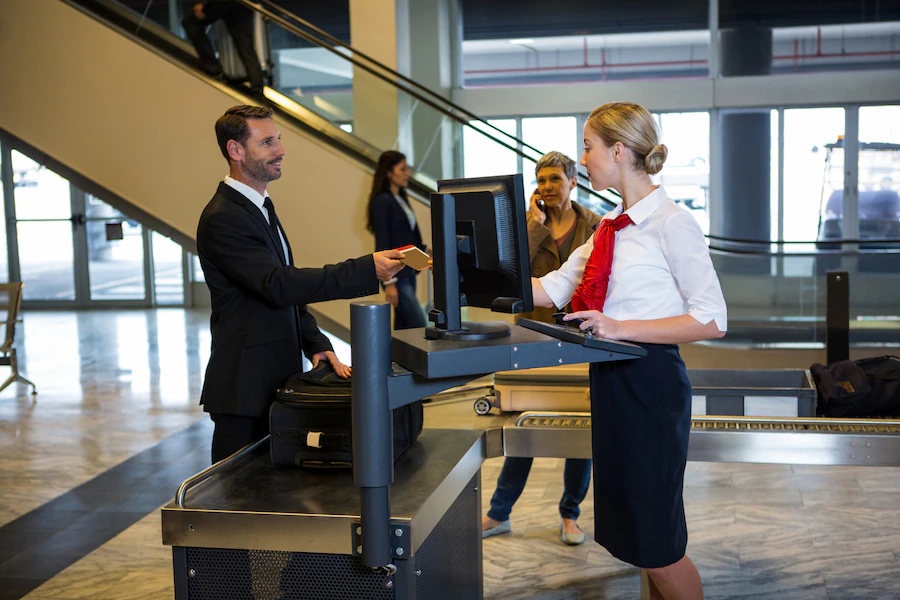Advancements In Biometric Identification For Enhanced Airport Security
Published on: September 11, 2023
Last Updated on: September 7, 2024

toc impalement
The rapidly transforming technological landscape at present calls for biometric identification, a cutting-edge solution that boosts airport security. Biometric technologies, including facial recognition, fingerprint scanning, and iris recognition, are revolutionizing the way passengers are identified, thereby reducing identity fraud and streamlining security procedures.
The Advantages Of Biometric Systems
The biometric systems have brought in a paradigm shift in security systems. They have been highly effective in meeting the needs of the people. Business organizations of diverse scales are using such technology in their frame. However, there are some of the core advantages of the biometric system. Let’s look at them in this section to understand them better.
Quicker Authentification
Previously, for businesses that opted for the pen-and-paper method, the employees were required to sign in a register before entering the office premises. This system is time-consuming. Moreover, this system could be more authentic.
However, the advent of biometric systems eliminated the need for physical attendance. But with the most advanced biometric systems, the employees use the retina to sign the records.
Improved Security System
Biometrics has simply improved the security system of the workplace to manifolds. With the most modern pins and security codes, it becomes difficult to crack it.
Moreover, the current biometric system has some of the most sophisticated and advanced technology to manage your security. There, you have different modes like face scanners, fingerprints, and retina recognition. Additionally, the system can also help you protect your sensitive data. This is because the fingerprints and the eye retina can not have a duplicate version. This is why they are becoming popular with time.
Maximizing Convenience
Another benefit you have with the help of the security system is convenience. This is because they provide the most authentic sign-in and sign-out data. The HR officers do not have to browse the attendance sheets and calculate the leaves. They help the office calculate the late sign-ins or overtime.
Previously, with the pen and paper system, it was quite difficult. The handy tools help gather all the information on your behalf, and you really do not have to bother too much about recording the information.
Scalability
You can use the biometric systems for not one but multiple purposes. You can use them for the new departments alike. In a way, it is one of the most scalable security solutions for both big and small business organizations today.
Flexibility
The biometric system not only offers scalability but flexibility, too. The biometric identification system offers flexibility by eliminating the need for remembering passwords or pins. You may know that today’s smartphones are fitted with a fingerprint scanner. They allow the users to quickly acces the files on their phones.
Profitability
The ultimate aim of inducting any system or mechanism is to ensure the optimization of the outputs and profitability. The Return on investment is obviously the objective. With the biometric system’s help, you can track employees’ entry and exit from the office. With improved productivity, the business will be able to get the maximum out of the investment.
Complete Accuracy Of Data
There is a heaven-and-hell difference between the accuracy of a human being and a machine. Any mechanism regulated by humans is prone to errors. On the other hand, the devices like the biometric system provide the most accurate data to the organization, which is almost impossible to replicate. Thanks to the high-end technology that is fitted to the machines.
Apart from the flow of advantages, there are also a few disadvantages. This technology creates problems for disabled people. Furthermore, they are expensive on the pockets, mainly for the small business.
Evolution in Biometric Identification
In this section, we go through the technological aspects that made biometry identification a real success.
Facial Recognition
Facial recognition is a technology that has made remarkable strides in the past few years, offering a seamless and efficient solution for airport security. By analyzing unique facial features and patterns, this technology enables swift and accurate identification of passengers.
Integrated into security systems, facial recognition has the potential to significantly reduce wait times at checkpoints while maintaining a high level of accuracy. This advancement not only enhances security but also offers a more convenient and pleasant experience for travelers.
Fingerprint Scanning
Fingerprint scanning, a tried-and-true biometric method, has undergone substantial improvements, making it an unparalleled tool for airport security. Modern fingerprint scanners employ advanced algorithms to create intricate fingerprint maps, ensuring that even the minutest details are captured.
The integration of such scanners into security protocols adds an extra layer of authentication, making it extremely challenging for impostors to breach the system. This development contributes to heightened security measures at airports and bolsters passenger confidence in the screening process. If you need additional information on airport security technology, you can find it here.
Iris Recognition
Iris recognition technology has gained prominence for its accuracy and non-intrusiveness. The intricate patterns of the iris are unique to each individual and remain stable over time, making them an ideal identifier for security systems. With the implementation of iris recognition, airports are able to enhance their ability to accurately identify passengers even in high-traffic scenarios. This biometric solution is not only reliable but also ensures a hygienic and touch-free experience, aligning with modern health and safety concerns.
Mitigating Identity Fraud And Ensuring Privacy
The integration of these biometric technologies goes beyond convenience; it serves as a potent deterrent to identity fraud and security breaches. As biometric data is inherently difficult to replicate, the risk of unauthorized access is significantly reduced. Moreover, stringent data protection measures are put in place to ensure the privacy and security of passengers’ biometric information. This delicate balance between security and privacy underscores the commitment of airports to provide a safe and respectful environment for all travelers.
Conclusion
The evolution of biometric identification technologies marks a transformative shift in airport security practices. Facial recognition, fingerprint scanning, and iris recognition have emerged as powerful tools to combat identity fraud and streamline security procedures. By embracing these advancements while addressing associated challenges, airports are poised to provide a safer and more efficient travel experience for passengers around the world.
Read Also:




















Comments Are Closed For This Article